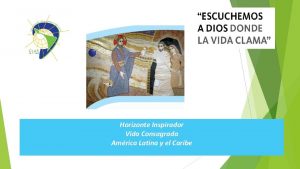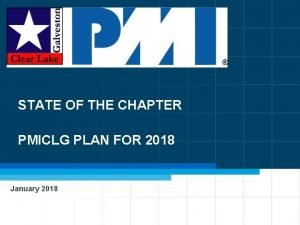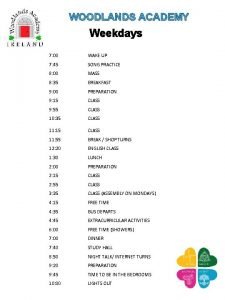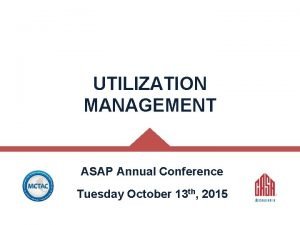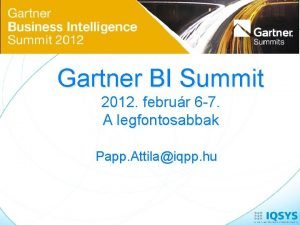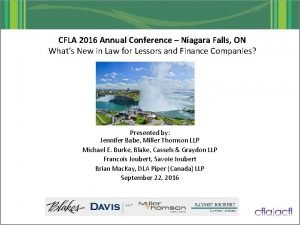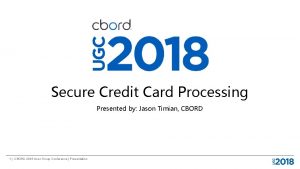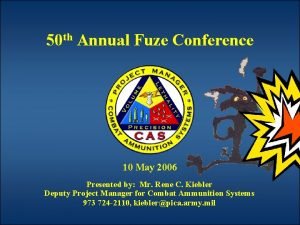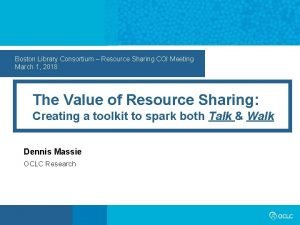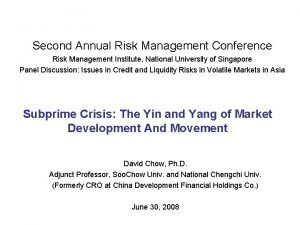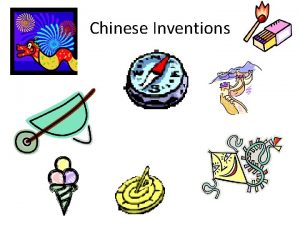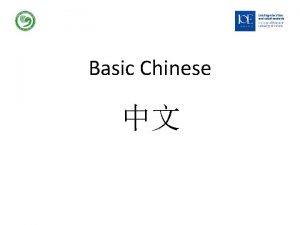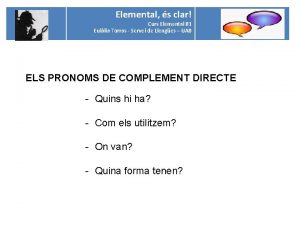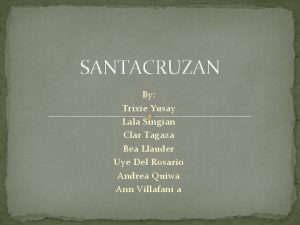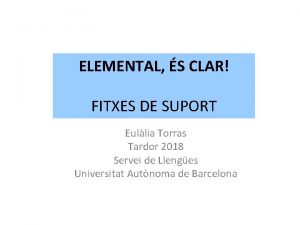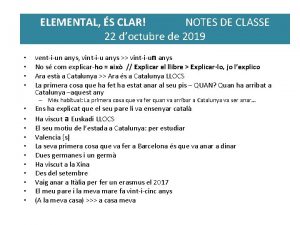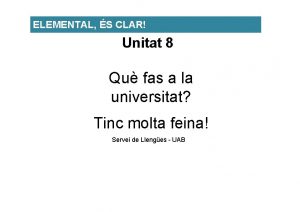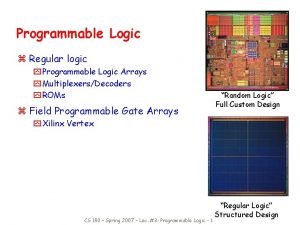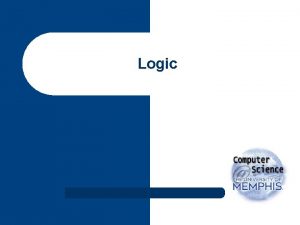CLAR 2018 2 nd Chinese Conference on Logic



![Computational Metaphysics Gödel/Scott’s Ontological Argument [Benzmüller&Woltzenlogel-P. , IJCAI, 2016] and many other variants. . Computational Metaphysics Gödel/Scott’s Ontological Argument [Benzmüller&Woltzenlogel-P. , IJCAI, 2016] and many other variants. .](https://slidetodoc.com/presentation_image/2b08d33d9a83adfead13a74c96b45baa/image-4.jpg)




























- Slides: 32

CLAR 2018 – 2 nd Chinese Conference on Logic and Argumentation Computational Hermeneutics: Using Computers for the Logical Analysis of (Philosophical) NL Arguments David Fuenmayor Free University Berlin david. fuenmayor@fu-berlin. com Christoph Benzmüller University of Luxembourg and Freie Universität Berlin c. benzmueller@fu-berlin. com

Logic as ars iudicandi Leibniz’s Dream: “. . . if controversies were to arise, there would be no more need of disputation between two philosophers than between two accountants. For it would suffice for them to take their pencils in their hands and to sit down at the abacus, and say to each other: Calculemus. ” characteristica universalis

Logic as ars iudicandi Improved ITP & ATP technology has led to success stories in mathematics … ● ● Erdös-Selberg’s proof of the Prime Number Theorem (about 30, 000 lines in Isabelle) Proof of Four Color Theorem (60, 000 lines in Coq) Proof of the Jordan Curve Theorem (75, 000 lines in HOL-Light). Proof Kepler’s conjecture by Thomas Hales (> 100, 000 lines of Isabelle and HOL-Light) . . . and also in metaphysics ● Automation of variants of Ontological Argument for the Existence of God [IJCAI 2016, . . . ] ● Formalisation of Zalta‘s Pricipia-logico Metaphysica [submitted (ar. Xiv preprint)]
![Computational Metaphysics GödelScotts Ontological Argument BenzmüllerWoltzenlogelP IJCAI 2016 and many other variants Computational Metaphysics Gödel/Scott’s Ontological Argument [Benzmüller&Woltzenlogel-P. , IJCAI, 2016] and many other variants. .](https://slidetodoc.com/presentation_image/2b08d33d9a83adfead13a74c96b45baa/image-4.jpg)
Computational Metaphysics Gödel/Scott’s Ontological Argument [Benzmüller&Woltzenlogel-P. , IJCAI, 2016] and many other variants. . . Lowe’s Modal Ontological Argument [Fuenmayor&Benzmüller, Log. Univ. , forthcoming]

Gödel‘s / Scott‘s Variants of the Ontological Argument

Gödel/Scott’s Ontological Argument Kurt Gödel’s Variant - Higher Order Modal Logic: Quantification over properties and “possible worlds” - Positive properties (say, being honest) are necessarily so. I. e. , an alternative world in which being honest is a bad thing would be inconceivable (see A 4) - Inconsistent Axioms - Modal Collapse: No free will? Dana Scott’s Variant - Melvin Fitting’s Variant - Similar to Scott’s - Avoids Modal Collapse: uses intensional types and postulates that only extensional properties can be said to be positive or negative Similar to Gödel’s Avoids inconsistency: Essential properties must be possessed by the individuals that feature them Anthony Anderson’s Variant - Similar to Gödel’s - Avoids Modal Collapse by allowing - properties that are neither positive nor negative (see A 1)

Lessons Learned Analyzing Arguments in Metaphysics is ● not only about proving facts by logical deduction (logic as ars iudicandi ), ● but also about understanding concepts better, highlighting inconsistencies, redundancies, implicit assumptions, etc. (logic as ars explanandi ).

Logic as ars explanandi: Tackling the Problem of Formalization

Past Approaches to the Problem of Formalization Project I: Development of an effective formalization procedure for natural language ➢ ➢ Davidson’s Theory of Meaning (e. g. Logic of Actions and Events) Chomsky’s Generative Grammar Montague Universal Grammar (and followers: DRT, DPL, etc. ) Reflective Equilibrium Method (e. g. Peregrin and Svodoba 2017) Project II: Develop criteria to evaluate formalization attempts (e. g. is a given formula is an adequate formalization of some given natural language text) ➢ ➢ ➢ Blau, U. : 1977, Die dreiwertige Logik der Sprache Epstein, R. L. : 1990/4, The Semantic Foundations of Logic (Parts I - II) Sainsbury, R. M. : 2001 (1991), Logical Forms. Brun, G. : 2004, Die richtige Formel. Philosophische Probleme der logischen Formalisierung. Baumgartner M. and Lampert T. (2008) Adequate formalization.

Inferentialist/Syntactic Criteria (Peregrin & Svodoba 2017) Peregrin J. and Svoboda V. (2017) Reflective Equilibrium and the Principles of Logical Analysis: Understanding the Laws of Logic. Routledge Studies in Contemporary Philosophy. Taylor & Francis, 2017. Principle of Reliability (aka. Correctness): Intuitively incorrect arguments should be logically incorrect. But: Verifying argument’s correctness involves all of the argument’s sentences (+ implicit premises): it is holistically determined.

Inferentialist (aka. Syntactic) Criteria (Peregrin & Svodoba 2017) Principle of Ambitiousness (aka. Completeness): Don’t play safe! Always look for the inferentially most fruitful formalization, i. e. the one which renders as logically valid the highest number of intuitively correct arguments.

Inferentialist (aka. Syntactic) Criteria (Peregrin & Svodoba 2017) Principle of Transparency: Principle of Parsimony:

A Holistic View on Formalization. . . much of the interest in logical form comes from an interest in logical geography: to give the logical form of a sentence is to give its logical location in the totality of sentences, to describe it in a way that explicitly determines what sentences it entails and what sentences it is entailed by. The location must be given relative to a specific deductive theory; so logical form itself is relative to a theory. Donald Davidson - Action and Reaction (1970)

A Holistic View on Formalization • • • holistic, iterative, give-and-take enterprise start with (tentative) candidate formalizations of some simple statements use them as stepping stones for the formalization of the remaining statements Example: If, for some candidate formalization Φ of an statement S, we find out some logically correct (but intuitively incorrect) argument form involving Φ (as a counterpart of S), we may, instead of dropping the hypothesis that Φ is an adequate formalization of S, consider keeping the hypothesis at the cost of dispensing with formalizations of some of the other statements involved in the counterexample. ➢ The formalizations of individual statements are holistically interconnected!

Criticism of Holistic Approaches … that the same way that the whole is, of course, understood in reference to the individual, so too, the individual can only be understood in reference to the whole. Friedrich Schleiermacher (1829) Whole-and-Part Hermeneutic Circle: • Formalization of an argument sentence becomes tested by computing the logical validity of the whole (formalized) argument. • The formalization of whole argument depends (compositionally) on formalization of constituent sentences. Underdetermination of the Theory of Choice (“Evidence alone cannot dictate the choice of a theory“) The result of any adequacy test is dependent not only upon the choice of the particular formula that is tested, but also on the formulas selected as formalizations of other sentences appearing in the testing arguments (cf. Quine’s Indeterminacy of Translation) Practical Unfeasibility Even for the simplest argument it involves a search over a vast combinatoric of candidate formalizations, whose validity has to be tested at least several hundreds of times (also to account for logical pluralism).

Our Proposal: Integrate a C alculus Ratiocinator with existing Arsenal of Tools NLP Statistical Methods Argumentation DRT/DPL TAG/CCG. . . Ontologies Machine Learning

Our Proposal: Use ATP for Assessing Inferential Criteria

Our Proposal: Use ATP for Assessing Inferential Criteria What do we need? ➢ Datasets of intuitively correct arguments and inferences. ➢ A “bootstrapping” mechanism to generate a (rough) initial formalization of the argument. ➢ Mechanisms to generate further candidate formalizations (varying/merging previous ones). And most importantly: ➢ A mechanism to evaluate the inferential (and syntactical) adequacy of a candidate formalization: ATPs and Model Checkers.

Can this ever lead to an effective formalization procedure? We humans have never been able to replicate something more complicated than what we ourselves are, yet natural selection did it without even thinking. Don't underestimate the power of survival of the fittest. And don't ever make the mistake that you can design something better than what you get from ruthless massively parallel trial-and-error with a feedback cycle. That's giving your intelligence much too much credit! Linus Torvalds

Massively Parallel, Trial-and-Error Approach to Logical Analysis with a Feedback Cycle • The problem of formalization becomes a combinatorial optimization problem. • Inferential and syntactic criteria of adequacy (cf. Peregrin and Svodoba 2017) can be used to define the utility/fitness function. • However, our main selection criteria will be: a chosen formalization must validate the argument, avoid inconsistencies, avoid undesirable side-effects (cf. Principle of Charity). • For ‘tricky‘ philosophical arguments we can expect our selection criteria to prune most of the search tree. • Evaluation of our utility function (or selection criteria) takes some seconds? • Highly parallelizable?

Repeat until reflective equilibrium The Computational Hermeneutics Approach Determine logical and extralogical vocabulary -> Language analysis Argument reconstruction (in natural language): Add/remove premises, conclusions and inferential relations according to informal/intuitive criteria Human- supported Computer-supported (NLP, lexicons, ontologies, etc. ) Knowledge-base of ‘correct’ arguments and inferences Semantic embeddings of non-classical logics in HOL How far have we deviated from the original argument? > Language synthesis Formalize argument in the spirit of the Principle of Charity. Iteratively do: Innovation mechanisms Introduce definitions and axioms (logic of formalization may vary as a result) Computer-supported (may require human intervention) Selection criteria Assess, e. g. : - Is the argument logically valid? - Does it ‘beg the question’? - Does it have unwanted logical consequences? Computer-automated (ATPs, Model Finders, etc. )

UNILOG 2018 - Logical Correctness Workshop - June 23, 2018 Questions? David Fuenmayor Christoph Benzmüller Free University Berlin david. fuenmayor@fu-berlin. com University of Luxembourg and Free University Berlin c. benzmueller@fu-berlin. com

Holistic Approach to Interpretation

A Case Study: Lowe’s Modal Ontological Argument (P 1) God is, by definition, a necessary concrete being. (P 2) Some necessary abstract beings exist. (P 3) All abstract beings are dependent beings. (P 4) All dependent beings depend for their existence on independent beings. (P 5) No contingent being can explain the existence of a necessary being. (P 6) The existence of any dependent being needs to be explained. (P 7) Dependent beings of any kind cannot explain their own existence. (P 8) The existence of dependent beings can only be explained by beings on which they depend for their existence. (C 1) All abstract beings depend for their existence on concrete beings. (C 7) The existence of necessary abstract beings needs to be explained. (C 8) The existence of necessary abstract beings can only be explained by concrete beings. (C 9) The existence of necessary abstract beings is explained by one or more necessary concrete beings. (C 10) A necessary concrete being exists. (Necessary existence of God) (D 1) x is a necessary being : = x exists in every possible world. (D 2) x is a contingent being : = x exists in some but not every possible world. (D 3 -4) The abstract/concrete distinction is exhaustive. (D 5) x depends for its existence on y : = necessarily, x exists only if y exists.

Shallow Semantic Embeddings (D 1) x is a necessary being : = x exists in every accessible possible world. (D 2) x is a contingent being : = x exists in some but not every accessible possible world. Enabling Technique: Shallow Semantic Embedding of Modal Logic in HOL. Modal operators and quantifiers are embedded as constants of a meta-language (Isabelle/HOL). More on semantic embeddings: Benzmüller, C. and Paulson, L. , Quantified Multimodal Logics in Simple Type Theory, Logica Universalis (Special Issue on Multimodal Logics) 7(1) (2013) 7 -20.

Existence, Contingentism and Actualist Quantification (D 1) x is a necessary being : = x exists in every accessible possible world. (D 2) x is a contingent being : = x exists in some but not every accessible possible world. Problem of Existence: We commit to Contingentism (instead of Necessitism). We need to restrict the domain of quantification at every world -> Actualist Quantification -> Varying Domains

Choosing a Logic for Formalization (D 1) x is a necessary being : = x exists in every accessible possible world. (D 2) x is a contingent being : = x exists in some but not every accessible possible world. We have just fixed our logic: (Free) Quantified Modal Logic (K). We can refer to non-actual objects No constraints on accessibility relation

Abstractness and Concreteness (D 3 -4) The abstract/concrete distinction is exhaustive. (P 2) Some necessary abstract beings exist. � Exists(x)

Ontological Dependence (P 3) All abstract beings are dependent beings. (P 4) All dependent beings depend for their existence on independent beings. dependent being A depends for its existence on B independent being

Metaphysical Explanation (P 5) No contingent being can explain the existence of a necessary being. (P 6) The existence of any dependent being needs to be explained. (P 7) Dependent beings of any kind cannot explain their own existence. (P 8) The existence of dependent beings can only be explained by beings on which they depend for their existence. A explains the existence of B existence of A is explained

Formalization of Premises

Formalization of Conclusions
 Ceip joan veny i clar
Ceip joan veny i clar Horizonte inspirador de la clar
Horizonte inspirador de la clar Anglo chinese school chinese name
Anglo chinese school chinese name B a f c j e
B a f c j e Pmi houston chapter
Pmi houston chapter Tlffra conference 2018
Tlffra conference 2018 Pfa conference 2018
Pfa conference 2018 National business group on health conference 2018
National business group on health conference 2018 Asha conference 2018 boston
Asha conference 2018 boston Tlffra conference 2018
Tlffra conference 2018 Adss conference 2018
Adss conference 2018 Februr
Februr Cfla conference 2018
Cfla conference 2018 Cigna conference 2018
Cigna conference 2018 Workforce planning conference 2018
Workforce planning conference 2018 Teachstone class video library
Teachstone class video library Freedom pay credit card processing
Freedom pay credit card processing Fuze conference 2018
Fuze conference 2018 Aatb conference 2018
Aatb conference 2018 Lifelong learning conference 2018
Lifelong learning conference 2018 Bccie summer conference 2018
Bccie summer conference 2018 Financial risk management conference 2018
Financial risk management conference 2018 Cmaa conference 2018
Cmaa conference 2018 Eacs conference 2018
Eacs conference 2018 Logic chapter three
Logic chapter three Software development wbs
Software development wbs Third order logic
Third order logic Combinational logic vs sequential logic
Combinational logic vs sequential logic Combinational logic sequential logic
Combinational logic sequential logic First order logic vs propositional logic
First order logic vs propositional logic Combinational logic sequential logic 차이
Combinational logic sequential logic 차이 Cryptarithmetic problem logic+logic=prolog
Cryptarithmetic problem logic+logic=prolog First order logic vs propositional logic
First order logic vs propositional logic

